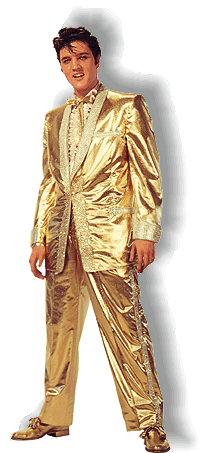 www.elvis.com
www.elvis.com |
Film, Audio and Video Terminology - 1 - 3
In discussing Elvis' movie and recording career, we often come across
terms not readily understood by the layman.
For the next few weeks we will be learning just what some of those words
mean. Here's the first round:
ACADEMY AWARD: Louis B. Mayer of MGM formed the Academy of Motion
Picture Arts and Sciences in 1926. His art director Cedric Gibbons
designed the award - a golden figure plunging a sword into the center of
a reel of film. The reel contained 5 slots for the 5 original branches:
producers, directors, writers, actors, and technicians. It was
originally named the "Academy Award of Merit". By 1933 it became known
as the "Oscar". Several people lay claim to coining the nickname but it
was more than likely Academy librarian Margaret Herrick who in 1931 said
the statue looked like her Uncle Oscar.
ACETATE: Safety base that replaced nitrate stock in 1950's as it is much
slower to burn.
ACTION: Word used to start filming of a take.
ADR: Automatic Dialog Replacement. Also known as "looping". A process of
re-recording dialog in the studio in synchronization with the picture.
ART DIRECTOR: Person who oversees the artists and craftspeople who build
sets.
ASSISTANT DIRECTOR: Assistant to the director, concerned with details of
administration rather than creation.
ASSOCIATE PRODUCER: This is normally the person who acts as the liaison
between a production company and the various personnel involved in the
post production process.
ATMOSPHERE: Extras who are staged and photographed to portray normal
human traffic needed to add detail in various script situations.
AUTHENTICATOR: Studio researcher responsible for establishing accuracy
of all script details.
BACK LOT: Area of a studio used to build large sets such as streets of
cities.
BACK PROJECTION: A method of producing "location" sequences in the
studio; the players act in front of a translucent screen on which the
scenic background is projected. {A good example of this technique is in
the movie "Fun In Acapulco" as Elvis and Raoul
ride the bike through the city.}
BACKING TRACK: Prerecorded accompaniment for a singer or voice-over
actor who then listens through headphones to a replay as he/she
performs. Generally, the two signals are ultimately mixed to produce the
final recording.
BAR SHEETS, LEAD SHEETS: A chart showing words of dialogue which have
been recorded, and the number of motion picture frames of duration for
each syllable.
BEST BOY: The assistant chief lighting technician or the assistant to
the key grip. (See "Key Grip" in an upcoming newsletter when we get to
the "K" listings.)
BLOCKBUSTER: A movie which is a huge financial success. In common usage
a movie that has a box-office of more than $100 million.
BLOCKING: Plotting actor, camera and microphone placement and movement
in a production or scene.
BURN-IN TIME CODE: A videotape in which a "window" displaying the time
code count on the tape is superimposed
over part of the picture.
BUS: A mixing network that combines the output of two or more channels.
CALL SHEET: A form which refers to all of the scenes to be filmed and
all of the personnel and equipment required for shooting on a particular
day.
CAMERA ANGLE: The view point chosen from which to photograph a subject.
CAMERA BLOCKING: The process of notating the changing position of the
camera, lens size, and focus during a particular scene.
CASTING DIRECTOR: Auditions and hires actors for films.
CATERER: Provides main meals for the cast and crew.
CD (Compact Disc): A digitally encoded disc capable of containing more
than one hour of music. The data is read by a laser beam.
CHANGEOVER CUE: A mark at the end of a release print reel to indicate
the moment at which to switch over to the next reel on the second
projector.
CINEMASCOPE: A trade name for a system of anamorphic widescreen
projection.
CINEMATOGRAPHER: Chief photographer.
CLAPBOARD/SLATE: A slate recorded at the beginning of a take with
details such as title, date, scene number and take number written on it.
Often has a hinged stick that is "clapped" for use in synchronizing
audio and video.
CLICK TRACK: A prerecorded track of electronic metronomic clicks used to
ensure proper timing of music to be recorded. Essential in music scoring
sessions. |

 www.elvis.com
www.elvis.com